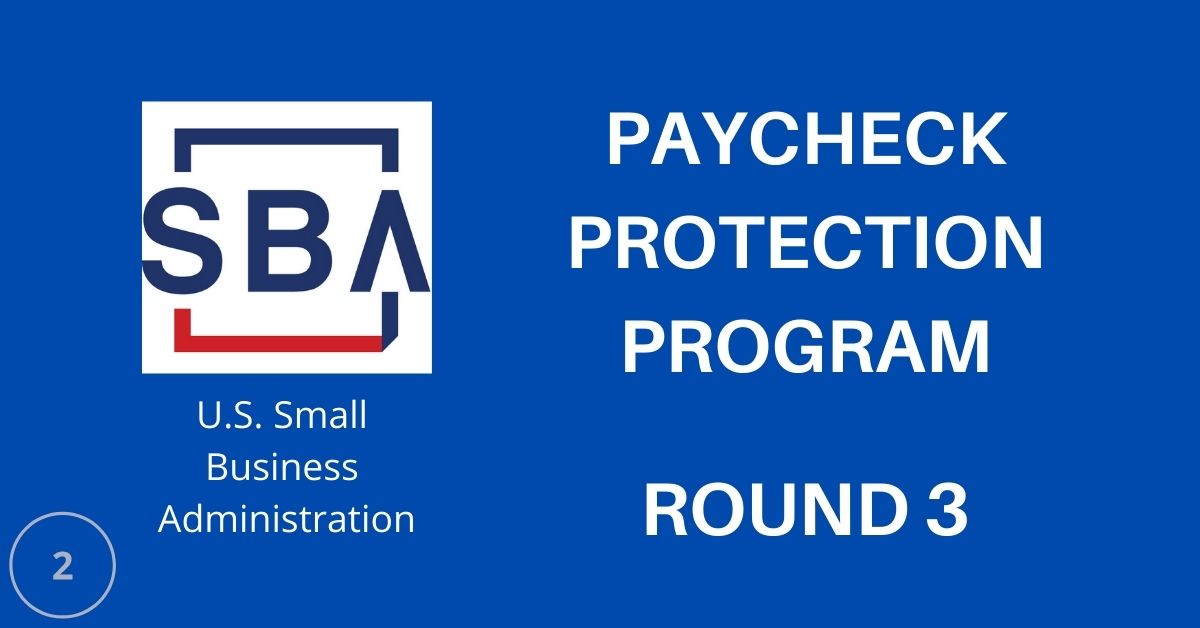Paycheck Protection Program Take Three? – Part 2

The previous post on the third round of funding for the Paycheck Protection Program covered the big stuff – the necessity test, qualifications for taking out a second loan, and the latest attempt at simplified forgiveness. Here in Part 2, I’ll be going over the finer details, including EIDL advances, expense deductions, the ERTC, and other notes and restrictions.
Covered Period
The Act will permit you to select your covered period (i.e., the period in which you must spend the PPP loan funds). The covered period must be greater than eight weeks and not more than twenty-four weeks beginning from the date of disbursement.
Economic Injury Disaster Loan (EIDL) Advances
Before the Act, borrowers that received an EIDL advance (typically between $1,000 and $10,000) had their PPP forgiveness reduced by the amount of EIDL advance. The Act provides that an EIDL advance will not reduce PPP forgiveness for new and old loans.
There has been some indication that those borrowers who already received forgiveness and had that forgiveness reduced by an EIDL advance will be able to amend their forgiveness applications. Keep an eye on this as more guidance will come.
Deductibility of Business Expenses and PPP Loan Forgiveness
One of the many political battles that occurred this summer was regarding the ability of businesses to deduct expenses if the business also received PPP funds for the same expenses. The Treasury Department and the IRS issued guidance that excluded businesses from deducting said expenses if they had received a forgivable loan. They stated that IRS Code Section 265 prohibits businesses from deducting expenses associated with tax-free income.
The Act reversed this guidance by explicitly permitting businesses to deduct expenses that were paid with forgiven PPP loans. This applies to both old PPP loans and new PPP loans issued under this Act with no limitations placed on businesses.
Also important to note: any forgiveness granted to a business would not be considered taxable income under the CARES Act passed in March 2020.
Payroll Credit for Employee Wages – the Employee Retention Tax Credit (“ERTC”)
The new Act expanded a tax credit known as the Employee Retention Tax Credit or “ERTC.” This change permits employers to claim a tax credit on up to $10,000 in wages paid to employees.
Originally the credit was limited to 50% credit on $10,000 in wages paid to employees per year. The Act increased the credit to 70% on $10,000 in wages paid to employees per quarter. This credit was extended through July 1, 2021.
To qualify for the credit, a business must meet one of the following:
- the business must be suspended or closed down by the government due to COVID-19 or
- the business must have 20% (down from 50%) less in gross receipts during the calendar year quarter when compared to the same quarter in the prior year.
For businesses with fewer than 500 employees (up from 100), the credit can also be applied to employees who were not able to complete their duties due to the business shut down or a lack of business so long as the employer continues to pay their wages.
ERTC and Paycheck Protection Program Exclusions
Employers can utilize the ERTC and PPP in the same tax year. However, unlike the deductibility discussed above, the ERTC and the Paycheck Protection Program funds cannot be used for the same expenses.
This means for any months that the PPP loan was used to pay employee wages, the employer cannot utilize the Employee Retention Tax Credit.
Restrictions on Chinese-owned Entities
Publicly traded businesses that are affiliated with the People’s Republic of China cannot qualify for a new PPP loan if the business
- was created or organized under the laws of China or Hong Kong
- has significant operations in China or Hong Kong
- owns or holds (directly or indirectly) not less than 20% of the business, or
- retains as a member of the board of directors a person who is a resident of China
China is the only restricted country in the proposed bill. It notably does not exclude North Korea, Iran, or Russia.
Eligibility for 501(c)(6) Non-Profits
The Act, for the first time, permits 501(c)(6) entities to apply for PPP loans. 501(c)(6) entities include chambers of commerce, real estate boards, professional football leagues, business leagues, and boards of trade so long as they are not organized for profit and no part of any net earnings are for the benefit of any individual.
These entities must not:
- receive more than 15% of their receipts from lobbying activities
- have more than 15% of their activities attributable to lobbying activities, and
- have the cost of lobbying activities exceed $1 million during the tax year ending on February 15, 2020.
PPP and Bankruptcy
Borrowers in bankruptcy are also eligible for the first time to apply for PPP loans. If you are a borrower who wishes to apply for a PPP loan and you are in bankruptcy, please consult with an attorney and a CPA before applying.
We’ve only just cracked the surface of the new PPP changes in the past two posts. As always, contact your legal counsel with any questions you may have.
